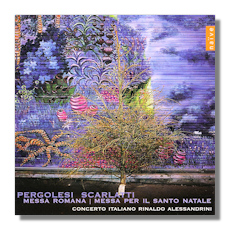
The Internet's Premier Classical Music Source
Related Links
-
Pergolesi Reviews
A. Scarlatti Reviews - Latest Reviews
- More Reviews
-
By Composer
-
Collections
DVD & Blu-ray
Books
Concert Reviews
Articles/Interviews
Software
Audio
Search Amazon
Recommended Links
Site News
 CD Review
CD Review
Italian Baroque Masses

- Giovanni Battista Pergolesi: Missa Romana
- Alessandro Scarlatti: Missa per il Santissimo Natale
Concerto Italiano/Rinaldo Alessandrini
Naïve OP30461
Rinaldo Alessandrini and his Concerto Italiano have a well-deserved reputation for combining insight, fresh interpretative vigor and wide-ranging technical accomplishment in their performances of the Italian late Renaissance and Baroque repertoires. This CD of two masses – from Pergolesi (1710-1736) and Alessandro Scarlatti (1660-1725) – stands as ample demonstration of these strengths.
The ten-strong choir, and orchestra of ten strings, four brass, three woodwind, harpsichord and organ make a splendid sound. From the opening note of Pergolesi's Missa di S. Emidio, written in 1734 and also known as the Missa Romana, one is struck by a great sense of purpose on the composer's part; this is well taken by Alessandrini and his forces. The eager reaction on opening a long-awaited book; and its perusal with care and delight. Notes are held devoid of all self-consciousness; the tempi are brisk and free from even a hint of bustle. The overall structure of the piece is brought out at the same time as an attention to individual moments of feeling – joy in particular.
The textures achieved in the performances of both works have a transparent and reflective quality; they are never either too dense or insipid. At the same time the precision and expressive nature of the solo singing and playing, especially when contrasted against the highly atmospheric instrumental work, make for persuasive performances that must put this CD firmly on the wish list: there is no other recording of the Pergolesi, and only one of the Scarlatti – on Stradivarius (STR33646).
The Missa Romana is one of only two masses safely attributed to Pergolesi, although seven more usually are. It was written to honor one of Naples" patron saints in the hope that he would intercede to prevent another earthquake like the one that devastated the city in 1731. In fact the Mass was also performed in Rome in homage to the Habsburgs, hence its (other) name.
It is a particularly lofty, pious and extrovert piece. But one full of grace – as Alessandrini and his musicians are well aware. Amongst other ways this is evident from the sparseness and concentration of the orchestration in places; some settings have a rather brief development, which suggests not levity, but confidence. In fact the whole piece lasts under half an hour. The singers and players have completely grasped the ethos and musical thrust of the Mass and entered fully into its spirit.
Variety is a key component: there is vivid color, poignancy, determination and commitment; and lots of excitement – listen to the end of the work, the Cum Sancto Spirito [tr.12], for example. Highly charged here – and executed with genuine delight and vim. Yet, it has to be added, never relying on spurious spectacle or redundant effect. It's hard to think that Pergolesi would not have approved of such a performance.
Scarlatti, also Neapolitan, wrote ten masses of which the Missa per il Santissimo Natale is the third, written in 1707 when the composer was maestro di cappella at the basilica of Santa Maria Maggiore in Rome. Although we are in a different, less "classical', world with this mass, it's just as rich and rewarding. In some ways it's a conservative work: Scarlatti's polychoral techniques look backwards… two distinct blocks of sound and no doubling of parts to speak of. At the same time there is richness: the contribution of two soloists and two solo violins adds a particular color, suitable for its intended use at Christmas.
In fact there are several moments when either the vocal melody and harmonies or the orchestration are especially rich… in the Credo [tr.15], for instance. There is much sound painting too, much evocation: the use of a repeated ritornello, for the violin, redolent of Corelli perhaps; the repetition of the Agnus Dei text (there is no Dona nobis pacem); the symbolic duple time at homo factus estin the Et Incarnatus est. This too is a relatively short work (also under half an hour). But a lot is packed into it, and all of this is revealed with great subtlety and confidence by Alessandrini and Concerto Italiano.
So with attention to detail, perceptive, lucid interpretations like these, a great recorded acoustic and Naïve's usually high standard of production (the booklet is clear and informative; there are full texts), this is a lively and exciting disc that can be warmly recommended not merely to expose Alessandrini and Concerto Italiano's strengths, but really for the opulence and depth of these two interesting and rarely heard masses.
Copyright © 2009, Mark Sealey




















